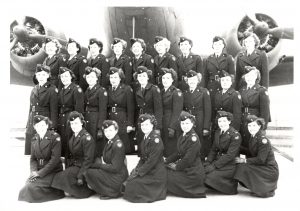Last in a series of eight blogs about the Drama of Nursing that set
the context for the role of the nurse character on the opera stage.
The Drama of Nursing
Part 7 Nurses on a Hero’s Journey on the Big Screen
Stereotypes can get in the way of nurses’ impression management as individuals and for nursing as a profession. But, as Darbyshire points out, it is not “particularly astute” to think that the media, whether in print, on stage, or onscreen, exists to depict nurses and their work “accurately … It is not nursing’s public relations machine.” 1 The same could be said for opera’s nurse characters.
In their study of the changing image of the nurse in mass media entertainment through the early 1980s, Kalisch and Kalisch identified five image types fundamentally coinciding with five successive time periods:
1854 – 1919 Angel of Mercy
1920 – 1929 Girl Friday
1930 – 1945 Heroine
1946 – 1965 Wife and Mother
1966 – 1982 Sex Object
The authors suggested that a sixth dominant image be added – that of Careerist, whom they define as a nurse who is “intelligent, logical, progressive, sophisticated, emphatic, and assertive” – in an attempt to chart a better future image for nursing. 2 They note that while the media continued to portray nurses in four of the above images, the nurse as heroine was quietly forgotten.
In the late nineteenth and early twentieth centuries, a woman’s decision to enter nurse training represented an adventurous step away from the sheltered family circle into a public space, though in reality she simply was trading one paterfamilias for another one inherent in the medical hierarchy. The dutiful daughter became the dutiful nurse, still under the watchful eyes of the ward sister and the attending physician. Kalisch and Kalisch consider a woman’s decision to become a nurse at that time a blow to rather than a mark of independence. In the late 1980s, the authors claim, a woman’s entrance into the nursing profession was “regarded as one more surrender to the narrowing of personal ambition [she could have been a doctor] and as an unadventurous acceptance of the strictures of gender-role specialization” that perpetuated the image of the nurse as “dependent and ineffectual in her attempts to direct her own destiny.” 3
The progression of images through the years suggests a journey, noted visually in changes in the nurse uniform for women over time. Cumbersome long skirts, snug bodices, and long sleeves gave way to practical battle fatigues when nurses went to war. Veils worn as part of religious attire were replaced outside the convent by caps, which eventually were abandoned. Pantsuits replaced nurse dresses, and more recently, scrubs became favored nursing attire. Bareheaded and dressed in scrubs – the least encumbered clothing throughout nursing history – rather than in traditional white with a distinctive cap on her head, nurses no longer project the visual code that once identified their profession.
Nurses’ attempts to direct their own destiny brings to mind the work of Joseph Campbell’s seventeen stages that heroes of mythology encounter in their journey of life, detailed in The Hero with a Thousand Faces. 4 The path that the hero takes is archetypal, and its narrative structures literature, film, and the performing arts, including opera. Heroes and heroines are the protagonists of the narrative, but antagonists, some of them villains, take a similar journey. As anti-heroes, these villainous characters heed a call to adventure, depart to cross the threshold into a world of wrong doing with no turning back, and experience obstacles to achieving their goal. The last one proves their undoing, they fail the final challenge, and experience death, jail time, or other punishment as reward, thus forfeiting the return to a grateful people. The line between who is the hero and who the anti-hero, however, is not always clear cut, for everyone is the hero of his or her own story, and even a villain’s acts can be well intentioned based on a thwarted sense of right and wrong. An overview of both journeys follows, using the four previously mentioned films with nurse characters as illustrations.
The many stages of the hero’s journey can be simplified into three. In the departure, a person in the ordinary world receives a call or summons to go on an adventure into the unknown. Nightingale’s eager acceptance of Sydney Herbert’s request that she take a band of nurses to the Crimea illustrates this stage. The adventure begins when the hero passes into a special world to face trials or tasks leading to the final challenge, which s/he overcomes, thus gaining a tangible or intangible reward – what the journey was all about – and earning hero status. This stage began for Nightingale when she stepped off the ship in Turkey and arrived at the Scutari hospital, where she encountered a medical staff resistant to her nursing efforts. Her perseverance in the face of opposition led to improved conditions for the British soldiers in her hospital. Having been transformed by the experience, the hero returns to the ordinary world with the reward s/he has earned to share for the benefit of others. Nightingale’s return to England where she applied herself to improving the health of the British army through sanitary reform and instituted nurse training at Saint Thomas Hospital illustrates this final stage of the hero’s journey.
Sister Luke, Major Houlihan, and her 4077th MASH nurses all make literal journeys – the former to the Belgian Congo, the latter to Korea. Nurse Ratched, whom moviegoers and critics alike identify as a villain, does not venture from home but makes a figurative journey. In the departure stage, she receives a literal call that a new patient is being brought to her ward. Any new patient arrives with a certain unknown, especially when of mental rather than physical origin. The adventure begins when Nurse Ratched meets McMurphy for the first time. Nurse and patient size each other up, and McMurphy creates the first of many obstacles to the inflexible ward schedule by requesting permission to watch the World Series at a time when the television is off limits. It soon is apparent that McMurphy’s behavior will continue to create obstacles to Nurse Ratched’s smooth running of her ward. The return to the ordinary world follows the most challenging obstacle of McMurphy’s stay – the all-night party. Nurse Ratched survives McMurphy’s attempt to choke her and avenges his treatment of her, though neither film nor book details her actions. When McMurphy returns to the ward after the lobotomy, it is as though nothing had disturbed its rigid schedule or its patients. Nurse Ratched has regained control and again is exercising her power over the lives of those committed to her care. Like other villains, Nurse Ratched believes that her approach – to mental health nursing in this case – is beneficial to her patients, though the impression she projects is not the one received by everyone in her “audience.”
A hero’s journey can be applied to opera’s nurse characters as well, some of whom experience a hero’s journey within their own opera. Dog Jennie’s journey in Oliver Knussen’s Higglety Pigglety Pop! (1990 Los Angeles), based on Maurice Sendak’s popular children’s book of the same title, is from boring home life to nursemaid – the Lion is her final challenge – to center stage. Morena as Goddess of the Underworld and as Voyslava’s nurse Svyatokhna in Nikolai Rimsky-Korsakov’s Mlada (1892 Saint Petersburg) and Die Amme, the nurse in Richard Strauss’s Die Frau ohne Schatten [The Woman Without a Shadow] (1919 Vienna) journey as anti-heroes from their ordinary world to another sphere where they encounter obstacles that thwart possession of a desired treasure – Prince Yaromir for Voyslava, and the Dyer’s Wife’s shadow for the Empress, respectively. While Morena’s revenge creates fire and destruction, Yaromir, not Morena, receives the reward when he is reunited in death with his beloved Mlada, whom Voyslava has helped to murder. Likewise, when the she refuses to take the shadow cast off by the Dyer’s wife, the Empress is given the reward of her own shadow and the return of her stone-cast Emperor husband, while Die Amme suffers an ignominious banishment from her ordinary world to the world of men, which she detests, as punishment. All of the operas are discussed more fully in The Nurse in History and Opera: From Servant to Sister.
To learn how the drama of nursing was reflected on the opera stage, see Judith Barger, The Nurse in History and Opera: From Servant to Sister (Lexington Books, 2024).
Notes
- Darbyshire and Gordon, “Exploring Popular Images,” 83. See also Darbyshire, “Heroines, Hookers and Harridans,” 60.
- Kalisch and Kalisch, The Changing Image of the Nurse, xi, 8, 184. Girl Friday corresponds with handmaiden.
- Ibid., 185.
- Joseph Campbell, The Hero with a Thousand Faces, Bollingen Series XVII (Princeton, NJ: Princeton University Press, 1st ed. 1949, 2nd ed. 1968).



